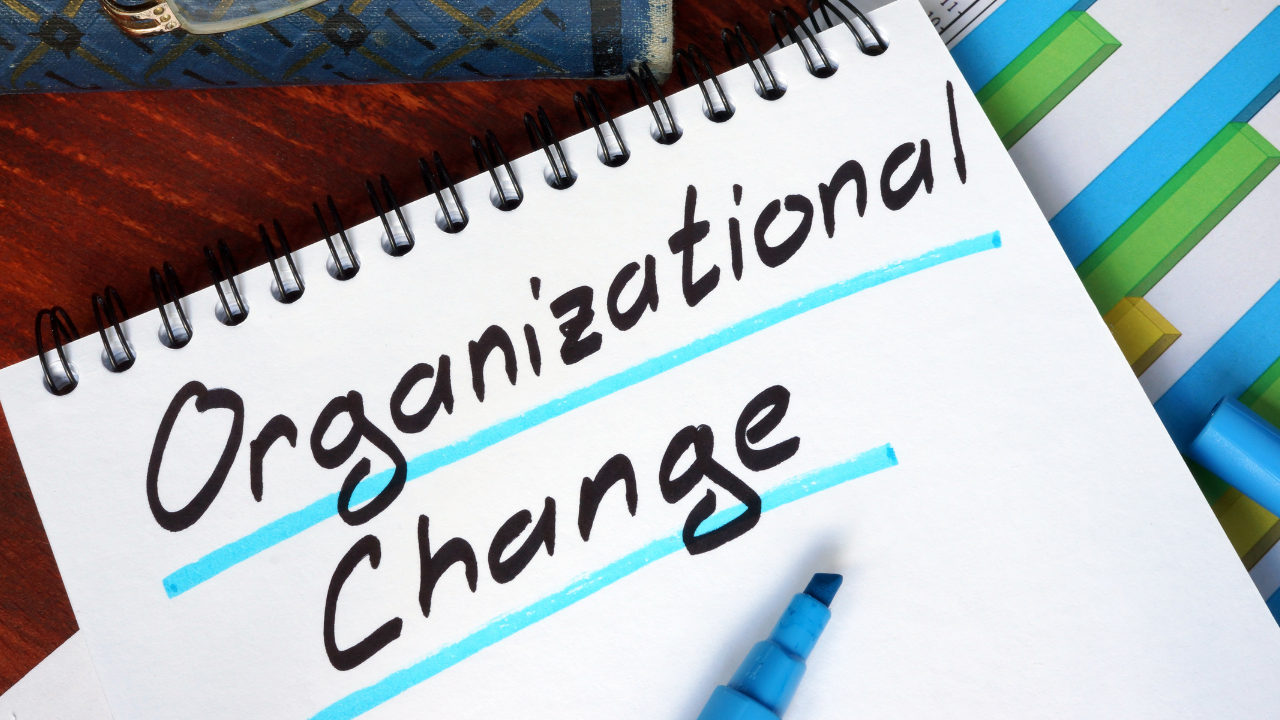How to Inspire and Sustain Lasting Organizational Change
Where do you get your inspiration for supporting clients with meaningful changes that last?
Change is complex, so every change manager, despite the fact they may use similar change methodologies, finds inspiration in various places.
Dr. Lynn Kelly is a great example of innovative change approaches. She is among the most interesting emerging change management thought leaders. She is a former vice president of supply chain and continuous improvement at Union Pacific Railroad. The inspiration for her change approach came from an unusual source: the Italian philosopher Machiavelli.
When she read that Machiavelli wrote that we must change to be successful, she was inspired. She formulated a way to maintain lasting change using Machiavellian philosophy. She reinterpreted it by shifting it away from the themes of conflict and into a helpful direction toward the logic of change management.
In 2023, the average employee experienced 10 enterprise changes in 12 months, causing severe change fatigue. New approaches to change management, such as Dr Lynn Kelly’s method, may reduce this fatigue.
This article explores Dr Lynn Kelly’s innovative approach to achieving lasting organizational change. After defining lasting organizational change, we will define the purpose of the change, leverage multi-level communication skills, invest in training, experiment with pilot programs, always prioritize culture, and measure success.
What is lasting organizational change?
Lasting organizational change is human-centric change, like using new technologies that stick and shifting the company’s focus to higher revenue and innovation. Organizational change management in the age of disruption is complex, making it challenging to create strategies to maintain long-term change.
Strategies to support lasting changes mean less wasted resources, less frustration, and higher employee retention as staff become resilient toward future changes.
Considering how to sustain lasting organizational change to reduce waste and end a successful change initiative with resilient, agile staff is essential. The first step is to define the purpose of the change and instill employees with this purpose.
Defining purpose
“Employees deserve to know their purpose within change.”
Dr. Lynn Kelly, LeadChange™ 2023
Consider the situational problem you aim to solve. This helps you create a purpose statement, and it’s what the best transformational leaders do.
This point might seem obvious if you already know the purpose of your change, but your definition may differ from that of leadership or the change facilitation team. This alignment between the purpose and how different tiers of the organization view it is crucial. Don’t overthink it.
If you struggle with it, it indicates its importance. You’re ready to implement it if you can easily communicate and align it. Why is this important? Consider this question: How often does a three-year-old ask “why” on a typical day? The answer might surprise you: it’s hundreds of times a day.
This innate curiosity extends beyond age three, often lasting until age six and far beyond into adulthood. Humans inherently seek to understand their experiences. According to a PwC study, millennials in the workforce need to understand the purpose of their tasks more than any other group (PDF). They deserve to know the purpose behind their work and changes.
When leaders acknowledge this need for purpose and the reasons behind the purpose of change, they embrace the transition and become champions for lasting organizational change. If leaders tell employees why they need to implement a change, the team feels more agency and responsibility, improving success rates.
Leverage multi-level communication skills
“Poor communication is often the first or second reason change initiatives fail.”
Dr. Lynn Kelly, LeadChange™ 2023
Communication is always a top factor in the success or failure of change initiatives. Effective communication is crucial, whether listed as the number one or two reasons. Therefore, change managers must emphasize its importance to leaders and help them dedicate significant energy to communication in change.
Prosci identifies frequent and open communication as one of the top three contributors to successful change, and this ranking increased from 6th in 2015 to 3rd in 2023. This point highlights its critical role. There are various elements to consider, starting with a vision statement.
It’s best to transform the initial purpose statement into a concise, motivating vision statement. Ideally, this is one sentence, or at most, two. It should be compelling and convey what’s in it for the audience.
Next, key messages are vital. Consistent messaging around the change is one of the identified success factors. Working with the team, define these key messages.
Multiple messages can be sent depending on the audience, such as distinct ones for unions, non-unions, and specific departments. Also, consider workplace trends like remote work and adjust communication to make it effective.
Such messages could relate to the amount of resources the team will need to dedicate to the change to make it successful or the vision of the change, to motivate employees to gain their buy-in.
If you’re unsure how to approach communication, check out our How To Guide for successful change management.
Invest in training
“Capability building is bigger than training.”
Dr. Lynn Kelly, LeadChange™ 2023
Training employees is important, but capability building extends beyond mere training.
During change implementations, employees often question how to handle new tasks with existing duties, requiring more resources or overtime. Pilots confirm these needs and determine if additional resources are necessary.
Leaders must justify overtime if required; otherwise, they reassure employees of successful resource management to maintain motivation.
Capability building involves ensuring employees have the tools, resources, and support to succeed. By addressing these needs comprehensively, organizations can facilitate smoother transitions and more effective implementation of new initiatives.
Experiment with pilot programs
“Target change agents to experiment and try things out.”
Dr. Lynn Kelly, LeadChange™ 2023
It can be useful to target change agents to conduct pilots or experiments and test new ideas in various ways, such as simulations. This approach allows change managers to trial changes effectively. But you shouldn’t stop there because your goal should be to influence the middle 60%.
One key aspect of change involves recognition. When organizations often implement changes and successes emerge, leaders scramble to publicize them. However, Dr. Lynn Kelly believes in pre-determining how to recognize success. She targets change agents for pilots or experiments, and the organization celebrates them extensively once she achieves success.
She showcases them in her client company’s newsletter and website, with managers and leadership highlighting their successes. This action sparks FOMO (fear of missing out) among the middle 60%, prompting them to inquire about similar benefits. This approach drives widespread adoption and ensures the success of our change initiatives.
Prioritize culture
“Culture permeates every aspect of change.”
Dr. Lynn Kelly, LeadChange™ 2023
Culture permeates everything. Let’s address the change question for culture. You’ve tried integrating cultural considerations throughout the change process, but this is a final check. For example, when designing improvements, try to understand the context in which the change occurs—that’s culture. Here, you ensure you address all cultural risks.
Consider the organization’s culture: How can you leverage it positively? If there’s a strong team-based culture, use it to support the change, perhaps by rolling it out in teams. Conversely, if the culture is risk-averse, consider mitigating this resistance. Review previous steps to see if you mitigated cultural risks; address them here.
Edgar Schein’s extensive research and three-tier organizational culture model show that changing culture is challenging and slow. Instead of aiming for immediate change, accept the existing culture and adapt your strategy accordingly. Successful programs can gradually influence culture, but it takes time.
Measure success
“Don’t use early indicator measurement tools forever.”
Dr. Lynn Kelly, LeadChange™ 2023
It’s crucial to utilize early indicators within the first 30 days of a change initiative instead of figuring out how to measure success at the end of the process. Implement these early indicators within the first few weeks to gather feedback.
For example, when working with Union Pacific, Dr. Lynn Kelly used a similar methodology to collect data while simultaneously rolling out changes at hundreds of locations. If locations were not progressing as expected, she would contact them, visit, identify issues, and assist in correcting their course before it veered too far off track. You can call these progress checks.
You should define specific measures to track progress. Aim for existing metrics, but if they are final output measurements, find earlier indicators. These early measurements shouldn’t become permanent as they can add bureaucracy; leaders should use them during pilots and initial rollouts until steady progress is evident.
Change your success metrics to fit the phase of your change initiative.
Seek lasting change inspiration in unusual places
As change managers, looking beyond traditional sources for inspiration to drive lasting change is crucial. Often, the most effective solutions come from unexpected places. Consider the creative strategies used in diverse fields such as art, nature, or philosophy.
For instance, the resilience of ecosystems can inspire new ways to build robust and adaptive organizational structures.
Peter Senge, known for his contributions to systems thinking and learning organizations, drew inspiration as far from the office environment as possible. His theories came from biology and ecology. He viewed organizations as complex systems akin to living organisms, where leaders approach change holistically to foster sustainable growth and adaptation.
Unconventional changes require unconventional solutions, and Dr. Lynn Kelly’s philosophical inspiration for finding a pathway to change can inspire your own solutions to help your clients succeed in change initiatives.







